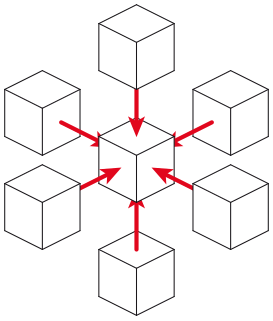This article has multiple issues. Please help improve it or discuss these issues on the talk page . (Learn how and when to remove these template messages) (Learn how and when to remove this template message)
|
A thread block is a programming abstraction that represents a group of threads that can be executed serially or in parallel. For better process and data mapping, threads are grouped into thread blocks. The number of threads varies with available shared memory. 'The number of threads in a thread block is also limited by the architecture to a total of 512 threads per block. [1] ' The threads in the same thread block run on the same stream processor. Threads in the same block can communicate with each other via shared memory, barrier synchronization or other synchronization primitives such as atomic operations.

In computer science, shared memory is memory that may be simultaneously accessed by multiple programs with an intent to provide communication among them or avoid redundant copies. Shared memory is an efficient means of passing data between programs. Depending on context, programs may run on a single processor or on multiple separate processors.
In computer science, synchronization refers to one of two distinct but related concepts: synchronization of processes, and synchronization of data. Process synchronization refers to the idea that multiple processes are to join up or handshake at a certain point, in order to reach an agreement or commit to a certain sequence of action. Data synchronization refers to the idea of keeping multiple copies of a dataset in coherence with one another, or to maintain data integrity. Process synchronization primitives are commonly used to implement data synchronization.
Contents
- Dimensions
- Indexing
- 1D-Indexing
- 2D-Indexing
- Hardware perspective
- Streaming multiprocessors
- Warps
- See also
- References
Multiple blocks are combined to form a grid. All the blocks in the same grid contain the same number of threads. Since the number of threads in a block is limited to 512, grids can be used for computations that require a large number of thread blocks to operate in parallel.
CUDA is a parallel computing platform and programming model that higher level languages can use to exploit parallelism. In CUDA, the kernel is executed with the aid of threads. The thread is an abstract entity that represents the execution of the kernel. A kernel is a small program or a function. Multi threaded applications use many such threads that are running at the same time, to organize parallel computation. Every thread has an index, which is used for calculating memory address locations and also for taking control decisions.

CUDA is a parallel computing platform and application programming interface (API) model created by Nvidia. It allows software developers and software engineers to use a CUDA-enabled graphics processing unit (GPU) for general purpose processing — an approach termed GPGPU. The CUDA platform is a software layer that gives direct access to the GPU's virtual instruction set and parallel computational elements, for the execution of compute kernels.

Parallel computing is a type of computation in which many calculations or the execution of processes are carried out simultaneously. Large problems can often be divided into smaller ones, which can then be solved at the same time. There are several different forms of parallel computing: bit-level, instruction-level, data, and task parallelism. Parallelism has long been employed in high-performance computing, but it's gaining broader interest due to the physical constraints preventing frequency scaling. As power consumption by computers has become a concern in recent years, parallel computing has become the dominant paradigm in computer architecture, mainly in the form of multi-core processors.
A Programming model refers to the style of programming where execution is invoked by making what appear to be library calls. Examples include the POSIX Threads library and Hadoop's MapReduce. In both cases, the execution model is different from that of the base language in which the code is written. For example, the C programming language has no execution model for input/output or thread behavior. But such behavior can be invoked from C syntax, by making what appears to be a call to a normal C library.













